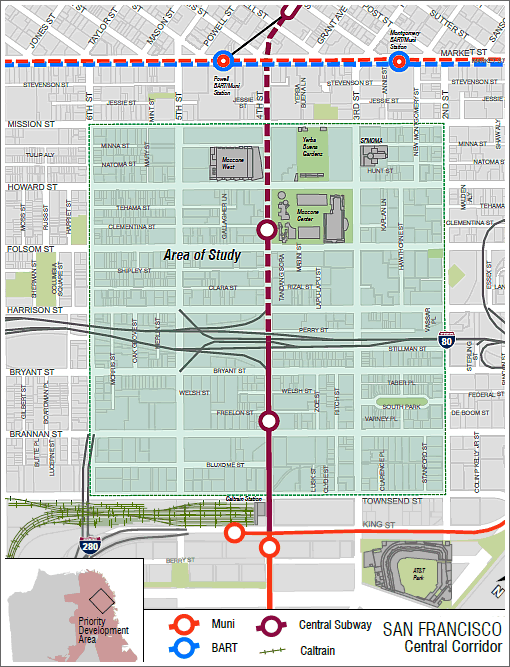
With the population of the Bay Area expected to increase from roughly 7 million to 9 million people over the next 30 years, an integrated long-range transportation and land-use/housing plan for the San Francisco Bay Area by Plan Bay Area projects San Francisco will add 190,000 new jobs by 2040.
And with an eye on high density, transit served locations to meet the projected growth, enter the Planning Department’s plan for the Central Corridor centered on the Central Subway line and Fourth Street in SoMa, between Townsend and Market Streets:
While the City has performed significant planning for housing in recent years, it has been somewhat less proactive in planning space for jobs, whose location have a much stronger correlation with transit usage than does housing location. With significant development occurring since the adoption of [San Francisco’s] Downtown Plan over twenty-five years ago, few significant Downtown building sites remain, and as job types and industries diversify, companies are seeking a wider range of spaces than the typical Downtown model can provide.
The [Planning] Department, in coordination with the Office of Economic & Workforce Development, is looking at a number of areas and opportunity sites around the City to support continued job growth and economic development consistent with regional environmental objectives. The Central Corridor, as a high-demand area with excellent regional transit accessibility, adjacency to existing job centers, diverse urban amenities and connectivity to San Francisco’s well‐educated workforce, is a key part of that comprehensive strategy.
The Central Corridor Plan Area, centered along the Central Subway and the Fourth Street corridor in SoMa between Townsend and Market Streets, offers a unique opportunity for integration of transportation and land use. The Central Corridor Draft Plan will propose changes to land uses and building height controls, public realm and open space improvements, strategies for preservation of neighborhood character and historic resources, and increased environmental sustainability.
Slated for publication early next month, San Francisco’s Planning Department will present an update on the development of their Draft Central Corridor Plan to San Francisco’s Planning Commission on Thursday.
Keep in mind that in order to support 190,000 new jobs, Plan Bay Area projects 92,000 new housing units will be built in San Francisco as well, double San Francisco’s current housing pipeline.
The headline should read SF Bay Area, not just SF.
[Editor’s Note: Nope. That 190,000 number is for San Francisco alone.]
“Excellent regional transit accessibility?” Good one. Certainly made me laugh.
A true vision would be proactive rather than just a lot of planning jargon and telling us what we already are investing in.
A real effort to connect a large transit investment with a big upzoning and some type of capture of the increased value makes sense
Geary seems logical for this sort of thing. Before they built the San Mateo BART extension there was another place where it seemed wise to be sure the investment was maximized. Instead we got Costco and a mall next to the BART stations
Zig, is the city merely telling you what you’re already investing in, or supporting and developing the value your investment? I don’t know what you’re complaining about.
Zig, the BART extension you mention goes to Millbrae, not San Mateo.
Geary seems like a corridor frozen in 1960. So much smart development and transit (read: Geary rail line) could be invested along this stretch to spread out the projected 200,000 new jobs.
I believe Zig was refering to the San Mateo COUNTY extension. BART is a three County District, and it was the County of San Mateo (via Samtrans) that negotiated the SFO extension and pays for a large portion of the operating costs. And Zig is correct…terrible decisions were made by San Mateo County jurisdictions about planning/zoning around BART Stations. Colma is the only success story so far, but it is completely hemmed in by the dead people.
I am complaining about the regional approach to public transportation planning and it is a bit of a rant I will admit
In addition to BART to San Mateo Country we have many other awful examples in the Bay Area like VTA lightrail which might be the most cost ineffective system in the world and BART extension to places like Warm Springs and then on to San Jose.
There is no real vision in a plan like this.